Listen, my children, and you will hear — the true story of Smokey the Bear
The Zoo has opened a new exhibit that tells the story of the real Smokey Bear. But do they have Hopalong Cassidy narrating it? We do!
In 1950, a tiny black bear cub was found clinging to a tree in Lincoln National Forest in New Mexico after a devastating forest fire destroyed more than 17,000 acres. “When it was all over, we heard this little strange noise and here was this bear cub up in a burned tree,” Forest Service ranger G. W. Chapman told Smithsonian magazine in 2005.

A burned bear cub survived the Capitan Gap fire in New Mexico’s Lincoln National Forest and was cared for by New Mexico Game Warden Ray Bell. The live cub, dubbed “Smokey Bear,” was donated to the National Zoo in Washington, D.C., where he remained until his death in 1976. (Image via National Historical Publications and Records Administration, National Archives)
The badly burned cub was estimated to be 3 months old. He was was dubbed “Smokey Bear,” inspired by the Smokey Bear Wildfire Prevention campaign managed by the U.S. Dept. of Agriculture’s Forest Service. After receiving treatment for burns to his paws and hind quarters, Smokey was flown to Washington, D.C., where he became one of the most famous residents in the Zoo’s 130-year history.
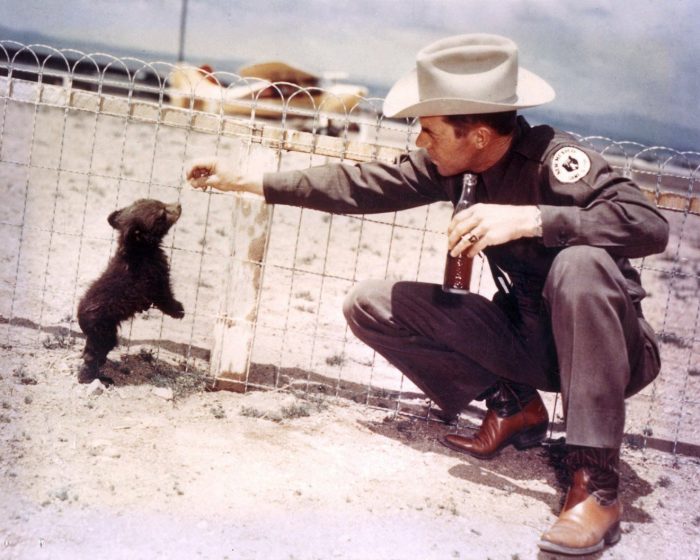
Ray Bell, right is shown in this undated photo playing with the young bear cub who would grow up to be named Smokey Bear. Bell, the game officer who cared for Smokey Bear after the young cub was rescued from a forest fire 50 years ago, died at the age of 89 at his home in Truth or Consequences, N.M. (AP Photo/Sierra County Sentinel, ho)
Yesterday, the Smithsonian’s National Zoo opened a new outdoor Smokey Bear exhibit inviting visitors to look back in time to the mid-20th Century, when the little cub became an iconic ambassador for wildfire prevention and wildlife conservation.
“I can think of no one better to tell the tale of how humans and nature are inextricably linked than our very own Smokey Bear,” said Steve Monfort, director of the the Zoo and Smithsonian Conservation Biology Institute. “His story is truly inspirational, and even though decades have passed since Smokey Bear lived here, the message of his famous character—protecting animals and their habitats—is timeless. We hope visitors come away with a deeper understanding of the Smithsonian’s role in helping the global community protect these critical ecosystems through our forest fire ecology research.”
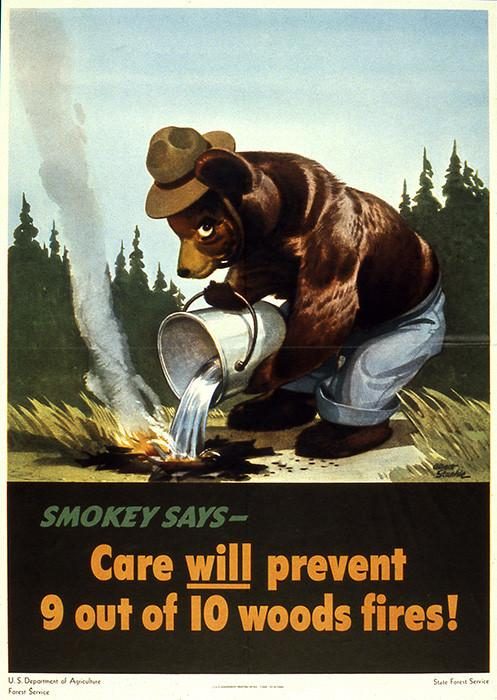
1944: Smokey’s first appearance on a Forest Fire Prevention campaign poster.
As visitors stroll through the exhibit, they will see the stories of both Smokey Bear the character and Smokey the Real Bear. The U.S launched the Smokey Bear Wildfire Prevention campaign in 1944 to protect forest resources during WWII. The Cooperative Forest Fire Prevention Committee chose a powerful yet friendly bear to speak for the forests. Posters show Smokey’s character through the decades, offering friendly tips on the proper way to extinguish campfires and advice on how to be a good steward of the environment. Several of the iconic Smokey posters, created by Forest Service artist Rudy Wendelin, helped shape the public identity of this beloved character.
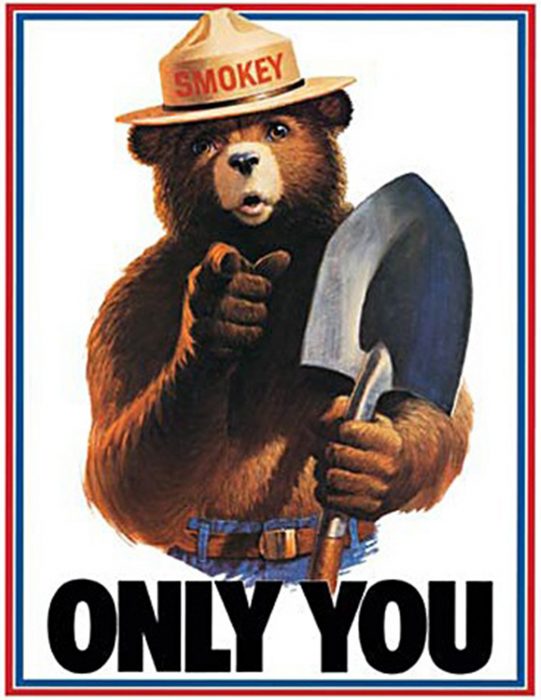
A 1984 poster features Smokey Bear the character and part of his famous catchphrase, “Only You Can Prevent Forest Fires.” Following a series of devastating wildfires in 2001, this slogan was changed to “Only You Can Prevent Wildfires.” Special Collections/USDA National Agricultural Library
The outdoor gallery also tells the story of the real Smokey Bear, who became a star and a must-see animal at the Zoo. Children sent the Zoo thousands of letters addressed to Smokey pledging their support for his junior rangers program. The volume of letters was so great, the United States issued Smokey Bear his own ZIP code—an honor bestowed only to him and the President of the United States. Although Smokey Bear the Zoo resident died in 1976, the character lives on through the campaign. His message—“Only You Can Prevent Wildfires”—is as relevant today as it was 75 years ago.
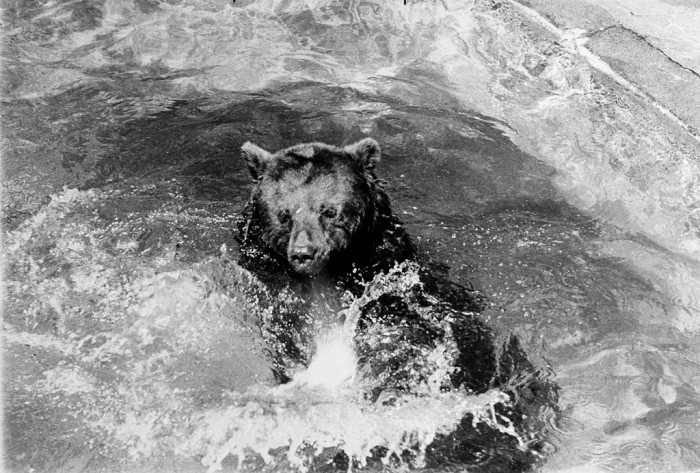
The original Smokey Bear frolicking in a pool at the National Zoo sometime in the 1950s. (Photo by Francine Schroeder, as featured in the Torch, December 1976)
In 1971, another black bear cub joined Smokey at the Zoo. Little Smokey was born in the Lincoln National Forest. He was not a victim of fire but had been orphaned and rescued from starvation by the Forest Service. Little Smokey would carry the torch of his namesake, who was nearing retirement (Smokey would turn 25 in 1975, which is the equivalent to roughly 70 human years, the mandatory retirement age for federal employees).
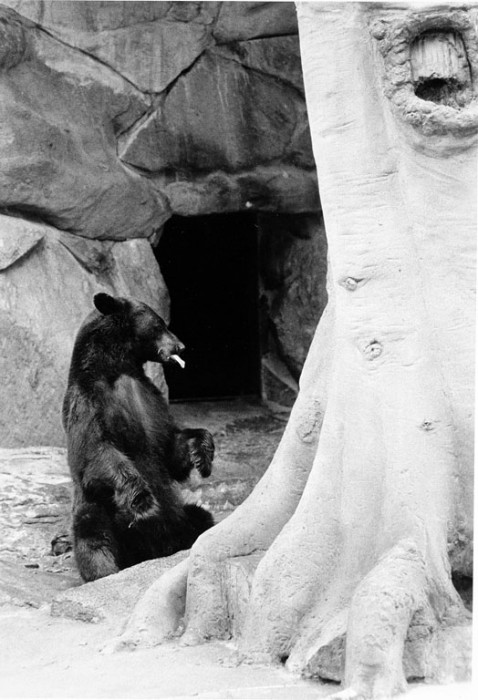
Smokey Bear enjoying the honey and berries that are dispensed from his new automated dispensing tree. National Zoological Park staffers from the offices of Graphics and Exhibits and Facilities Management put together the “honey tree” in Smokey’s exhibit area in the summer of 1984. The national symbol of forest-fire prevention was 40 years old in 1984. The Cooperative Forest Fire Prevention Program funded the construction. (Photo by Jessie Cohen, as featured in the Torch, November 1984)
The original Smokey bear died in 1976. A Congressional resolution of 1974 stipulated that Smokey’s remains would be returned to New Mexico, where he would be buried at the Smokey Bear Historical Park in Capitan, not far from where he was found.
“Smokey Bear was really a national icon for several generations,” says Pam Henson, director of the Smithsonian Institutional History Division. “When I was five years old in 1953, I broke my arm. To console me, I was allowed to pick out a toy and I chose a Smokey Bear stuffed animal, complete with uniform, badge, ranger hat and shovel. It was my favorite toy for many years. So of course, when I came to Washington and visited the National Zoo, Smokey Bear was my first choice to go see.”
Posted: 24 May 2019





